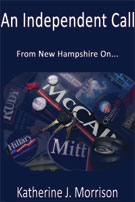Today is Tax Day Tea Party Day. There are tax protests scheduled around the country, and as I noted in a previous article, they’re even in Vermont. Boston and Atlanta are both expected to have huge numbers of protesters, and while there is no definitve count yet, it appears these Tea Parties will be large enough an numerous enough that even the main stream media won’t be able to ignore them.
A fascinating element of today’s protests is how Tea Party organizers harnessed the power of the internet to generate a truly grass roots movement. I recently wrote in my book, An Independent Call, conservatives do well in top down organizing, yet bottom-up cooperative organizing tends to fall flat. Conservative organizational strength is often dependent of the leadership and make up of each particular group. Yet Tea Party organizers just proved me wrong. What is remarkable about the organization of these Tea Parties is that they are being formed by a wide range of people in different areas of the country who are often not connected to each other.
Also, these protests are not solely the domain of the right. These Tea Parties are showing a wide range of people are fed up with Washington’s tax and spend policies. No doubt these events were aided by the simple fact that they hit nerve with citizens who are bailout weary.
Michelle Malkin’s article A Tax Day Tea Party cheat sheet: How it all started does a nice job in tracing the origins of the Tax Day Tea Parties, and includes a number of pictures from these protests showing that these are peaceful family friendly events.
The Wall Street Journal article Tax Day Becomes Protest Day also gives a nod to the grassroots formation of these protests.
So who’s behind the Tax Day tea parties? Ordinary folks who are using the power of the Internet to organize. For a number of years, techno-geeks have been organizing “flash crowds” — groups of people, coordinated by text or cellphone, who converge on a particular location and then do something silly, like the pillow fights that popped up in 50 cities earlier this month. This is part of a general phenomenon dubbed “Smart Mobs” by Howard Rheingold, author of a book by the same title, in which modern communications and social-networking technologies allow quick coordination among large numbers of people who don’t know each other.
Filed under: Economy, Independent, McCain, Moderate, Obama, Politics, media, republicans




[...] Tea Parties Harness the Power of the Internet SHARETHIS.addEntry({ title:’Tea Parties Harness the Power of the Internet’, summary:’Today is Tax Day Tea Party Day. There are tax protests scheduled around the country, and as I noted in a previous article, they’re even in Vermont. Boston and Atlanta are both expected to have huge numbers of protesters, and while there is no definitve count yet, it appears these Tea Parties will be large enough an numerous enough that even the main stream media won’t be able to ignore them.A fascinating element of today’s protests is how Tea Party organizers harnessed the power of the internet to generate a truly grass roots movement. I recently wrote in my book, An Independent Call, conservatives do well in top down organizing, yet bottom-up cooperative organizing tends to fall flat. Conservative organizational strength is often dependent of the leadership and make up of each particular group. Yet Tea Party organizers just proved me wrong. What is remarkable about the organization of these Tea Parties is that they are being formed by a wide range of people in different areas of the country who are often not connected to each other.Also, these protests are not solely the domain of the right. These Tea Parties are showing a wide range of people are fed up with Washington’s tax and spend policies. No doubt these events were aided by the simple fact that they hit nerve with citizens who are bailout weary.Michelle Malkin’s article A Tax Day Tea Party cheat sheet: How it all started does a nice job in tracing the origins of the Tax Day Tea Parties, and includes a number of pictures from these protests showing that these are peaceful family friendly events.The Wall Street Journal article Tax Day Becomes Protest Day also gives a nod to the grassroots formation of these protests.So who’s behind the Tax Day tea parties? Ordinary folks who are using the power of the Internet to organize. For a number of years, techno-geeks have been organizing “flash crowds” — groups of people, coordinated by text or cellphone, who converge on a particular location and then do something silly, like the pillow fights that popped up in 50 cities earlier this month. This is part of a general phenomenon dubbed “Smart Mobs” by Howard Rheingold, author of a book by the same title, in which modern communications and social-networking technologies allow quick coordination among large numbers of people who don’t know each other.Tea Parties Harness the Power of the Internet’ }, {button:true} ); Sphere: Related Content Share on Facebook Category: conservative web, tea party internet, tea party site, tea party web, web activism [...]
The American people do not like the direction that Obama has the Country going. If Obama and Congress both republicans and democrats don’t listen then we have to vote them out of office!
Our young people will be lucky to afford a car or a home and just as well forget having a family if Obama keeps spending and printing money.